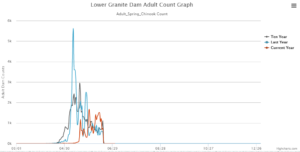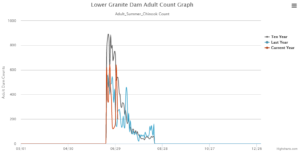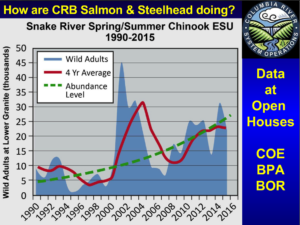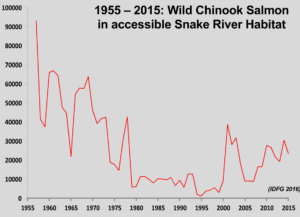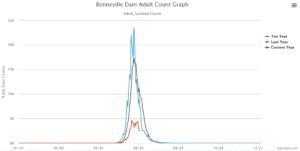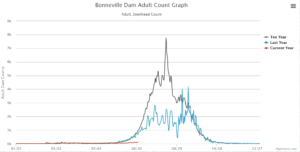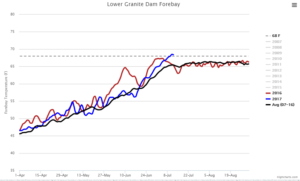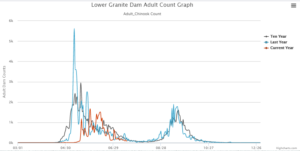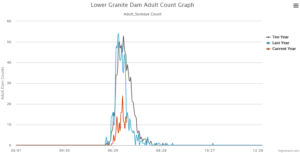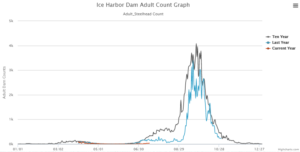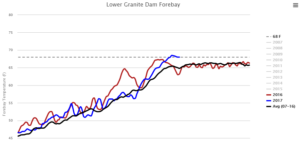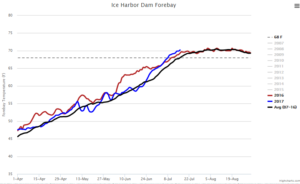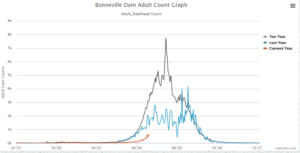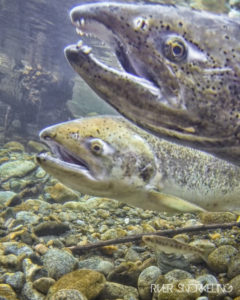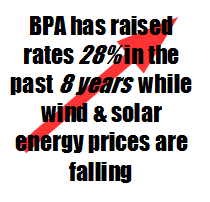July 12, 2017
Cathy McMorris Rodgers, U. S. House of Representatives (WA-05)
Jaime Herrera Beutler, U. S. House of Representatives (WA-3)
Dan Newhouse, U.S. House of Representatives (WA-4)
Kurt Schrader, U. S. House of Representatives (OR-05)
Greg Walden, U. S. House of Representatives (OR-2)
Greetings:
You recently sponsored a bill in the U. S. House of Representatives designed to protect the operation of the four lower Snake River (LSR) dams from environmental review and stop implementation of a scientifically-proven means (spill) of aiding threatened and endangered salmon and steelhead. Your statements in the press release addressing this bill, posted on McMorris Rodgers’ website, demonstrate either a lack of knowledge about the LSR dams or an attempt to deceive your constituents, colleagues in Congress and all Americans. Here are facts of which you are hopefully aware.
Hydropower
Those who wish to mislead the public frequently combine the power output of the Columbia River with that of the Snake, purposely failing to acknowledge that the LSR dams contribute little to the Northwest’s power supply. These four dams provide less than 4% of the electricity in the Pacific Northwest power grid and only 6.5% of the Northwest’s hydropower. They produce much of their power when demands for electricity and market price are both low.
PNW wind energy capacity is now three times greater than the combined capacity of all 4 LSR dams. The Pacific Northwest enjoys a surplus of energy, at times requiring wind turbines to be shut down and electricity to be exported at a negative price.
Savings in energy costs related to fish mitigation alone justifies breaching the LSR dams.
Navigation
Freight transport on the LSR’s four reservoirs has declined by more than 50% over the past 20 years. Barges no longer carry logs, lumber, paper, pulp, or pulse. Even grain volume, which makes up over 90% of all freight, has declined 45% over the same period.
Every barge of grain that leaves the Port of Lewiston carries a taxpayer subsidy of over $20,000 to pay for channel dredging, navigation operations and maintenance. This figure does not include the many millions of dollars spent every few years on major lock rehabilitation. Commercial navigation on the LSR principally provides government-subsidized transportation of a government-subsidized crop.
Flood Control
The LSR dams are run-of-the-river dams that provide no flood control. Lower Granite dam actually creates flood risk to the principal city on the waterway—Lewiston, Idaho. The arrival at the confluence of the Snake and Clearwater Rivers of over 2 million cubic yards of sediment each year perpetually adds to that flood risk and creates additional future costs to be borne by federal taxpayers. Flood control as justification for maintaining the LSR dams is a false claim.
Irrigation
Only one reservoir in the LSR dam complex — behind Ice Harbor Dam— provides irrigation for between 13-17 land owners/farms on one-third the acreage the Corps of Engineers projected in claiming benefits for the LSR project. Water would still be available if Ice Harbor were breached, but at a higher (non-subsidized) cost. Irrigation as justification for maintaining the LSR dams is a weak argument that applies to a single dam.
Juvenile Fish Migration
Among the more egregious of the false claims made in the press release addressing the proposed legislation is that of the survival of Snake River juvenile salmon and steelhead through the 8-dam Columbia/Snake River complex. The oft-repeated statement “an average of 97% of young salmon successfully make it past the dams” belies a juvenile fish survival rate through the dams and reservoirs of about 54% for wild Chinook and 45% for wild steelhead. Further losses then occur below Bonneville Dam due to avian predation and delayed mortality caused by the rigors of dam passage. In 2015 the juvenile survival rate Lower Granite to Bonneville for the Snake River’s most endangered fish, Idaho’s sockeye salmon, was 32%. In 2016 this rate declined farther to a mere 12%. The 97% claim is false. Repeating it constitutes political hucksterism.
In 2013, NOAA Fisheries acknowledged that no juvenile fish passage survival improvement had occurred over the previous 13 years—despite the expenditure of over $700 million on just the 4 lower Snake River dams for so-called “fish passage improvements.” Stated NOAA: “Chinook survival through the hydropower system has remained relatively stable since 1999 with the exception of lower estimates in 2001 and 2004.” No significant change has occurred in the past four years. Claiming otherwise is lying.
Adult Salmon Returns
As with hydropower, LSR dam supporters deceive the public by using data for the combined Columbia/Snake system, purposely ignoring the vast differences in fish numbers in these two rivers. As sponsors of the House Bill in question, you likewise employ this deception in claiming the achievement of “record fish returns.”
Historically, the Snake River produced an estimated half or more of all the anadromous fish in the Columbia Basin. However, in 2014 just 14% of the Chinook counted at Bonneville Dam were Snake River fish. For Coho the percentage was 6%, for sockeye it was less than half of one percent. The same pattern held in 2015 at 15%, 3.5%, and 2/10ths of one percent. Claiming that salmon numbers at Bonneville Dam provide meaningful and honest information about fish numbers on the Snake River, let alone about the Snake’s threatened and endangered salmon and steelhead, is beyond the pale.
In 2015, 99% of adult Snake River sockeye died before reaching their spawning grounds. The Idaho Fish and Game Department has predicted 2017 and 2018 will see steelhead returns lower than those in the 1980s, with the Clearwater River’s once famous wild B-run steelhead numbers predicted to be a mere 1000 fish in 2017.
The true measure of successful recovery of threatened and endangered fish species is the smolt-to-adult return (SAR) ratio. Mere survival (non-extinction) of wild fish species requires a minimum 1% SAR, while recovery of Snake River salmon and steelhead requires a 2%-6% SAR. From 1993-2013 the SAR for wild Chinook salmon averaged .89%. The return exceeded the minimum 2% SAR needed for recovery during only 2 of those 20 years. Idaho’s Snake River sockeye are on the brink of extinction. No Snake River threatened and endangered salmon or steelhead species is on a path to recovery.
The claim of “record runs of fish” in a bill designed to maintain the status quo on the lower Snake River is deliberate deception.
The High Cost of Failure
Several other statements you have made about the LSR dams fall beyond this communiqué—for example, your twisted claim that science should govern dam operations rather than politics while you undertake to assure that politics continue to defy science. However, one additional topic must be addressed. While I question your claim that “one-third of our electric bills pay for fish passage,” we do know the cost to taxpayers and ratepayers of supporting mostly failing salmon and steelhead recovery in the Snake and Columbia Rivers has topped $15 billion. As noted above, at least $700 million has been spent just on “system improvements” designed to increase the rate of juvenile fish passage on the four LSR dams. However, overall juvenile fish survival rates have not improved over the past 20 years, smolt-to-adult wild fish returns remain below the level needed to avoid species extinction, and no Snake River threatened and endangered species is on a path to recovery. Three federal judges over a twenty-year period have declared plans for the operation of the federal dams on the Columbia and Snake Rivers illegal. Despite all of this information, you 5 Northwest members of the U. S. House of Representatives, who claim to be fiscal conservatives, have sponsored a bill to continue pouring more taxpayer and ratepayer money into an atrociously expensive, flawed and failed experiment that is destroying two of the Pacific Northwest’s most iconic species —Pacific salmon and Southern Resident Killer Whales— while inflicting economic hardship on small communities from the Pacific Coast to the interior of Idaho.
A boondoggle is defined as “a wasteful or pointless activity that gives the appearance of having value; “ and “a public project of questionable merit that typically involves political patronage and graft.”
The lower Snake River dams meet both definitions. Your referenced House Bill does as well.
Linwood Laughy Kooskia, Idaho [email protected]
